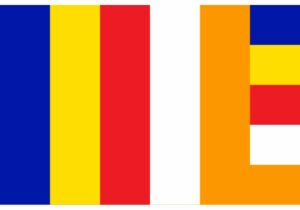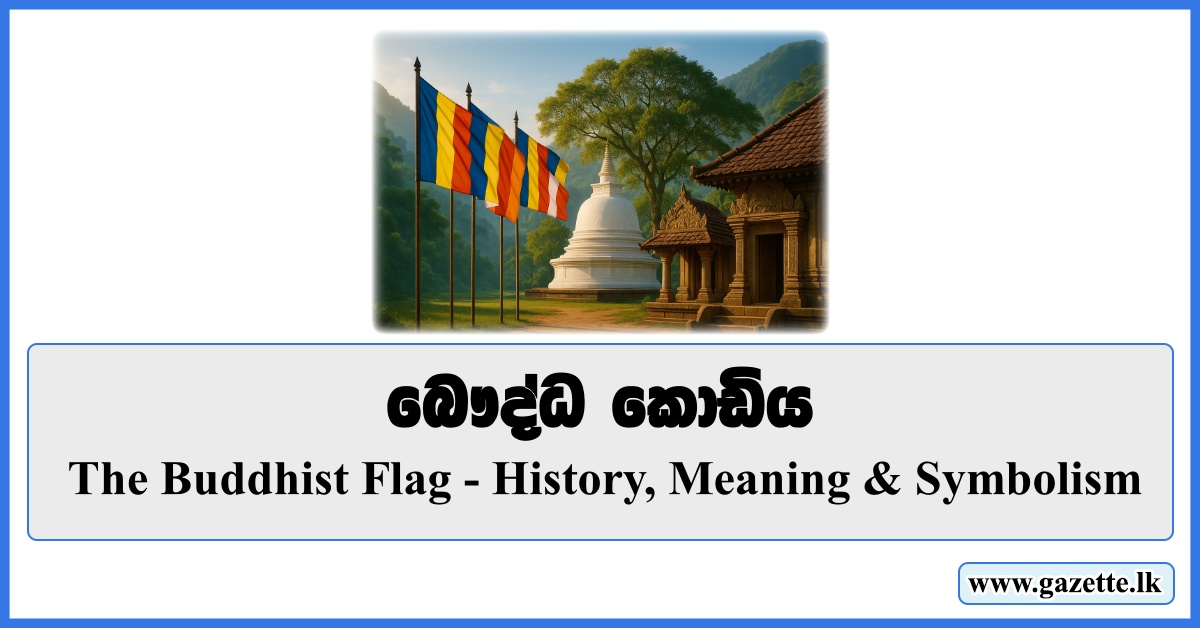Among all Buddhist symbols the Buddhist Flag stands as one of the most identifiable because it captures both fundamental Buddhist teachings alongside support from global followers. Buddhist groups scattered across the globe display the colorful banner during temple, monastery and festival events. The flag symbolizes Buddhist harmony and peaceful acceptance while manifesting the universal benefit of Buddhist teachings among all people. An examination of the present significance follows a study of historical development together with design principles which includes symbolic elements for Buddhist flags.
“The Buddhist Flag is not just a banner. It’s a symbol of peace, a call for unity, and a celebration of enlightened teachings.” – Ven. Kirinde Dhammananda Thera
A Brief History of the Buddhist Flag
Born in 1885, the Buddhist flag came from the combined efforts of Sri Lankan Buddhist leaders and co-founder of Theosophical Society Colonel Henry Steel Olcott to provide a unified emblem for Buddhists around. Rising as a lighthouse for religious rebirth, it emerged in response to the decline of Buddhism during the colonial era.
The Buddhist flag was co-founded in 1885 by:
Key Founders of the Buddhist Flag:
-
Colonel Henry Steel Olcott – A Buddhist reformer and American Theosophist who significantly contributed to the Buddhist rebirth in Sri Lanka.
-
Ven. Migettuwatte Gunananda Thera – A well-known Buddhist monk from Sri Lanka distinguished for his leadership in efforts at Buddhist revival.
-
The Colombo Committee – A group of Buddhist lay leaders from Sri Lanka cooperating to create the flag.
This collaborative effort aimed to restore Buddhist identity during colonial rule and create a symbol of unity and peace among Buddhists worldwide.
Buddhist Flag Timeline (1885–Present)
| Year | Milestone |
|---|---|
| 1885 | First hoisted in Sri Lanka |
| 1952 | Adopted by World Fellowship of Buddhists |
| 2000s–Now | Recognized globally at Buddhist temples and festivals |
Design and Symbolism: What Do the Colors Mean?

Each of the six stripes has deep symbolic significance in Buddhism:
| Color | Symbolism |
|---|---|
| Blue | Universal compassion |
| Yellow | The Middle Path |
| Red | Blessings from practice |
| White | Spiritual liberation |
| Orange | Essence of Buddha’s wisdom |
| Mixed | Unity of all teachings |
Download Buddhist Flag Meaning (PDF)
A Global Symbol Across Traditions
Theravāda, Mahāyāna, and Vajrayāna Buddhists all around are united by the flag. It’s seen waving during Vesak, Poya Days, ordination ceremonies, and even international peace events.
Significance of the Buddhist Flag
All members of Buddhism worldwide view the Buddhist flag as holding a crucial set of symbolic references. All four major Buddhist traditions under the Theravada and Mahayana and Vajrayana categories find representation in this international symbol. Global Buddhists experience religious unity because the flag connects them across their various geographical and territorial boundaries.
Promoting Peace and Non-Violence
Buddhist flag serves to represent essential Buddhist values of non-violence and compassion and peace during festival rituals and religious ceremonies. This banner extends past all limits to foster harmony between Buddhists worldwide and external civilizations.
A Symbol of Revival and Strength
In Sri Lanka the Buddhist flag represents Buddhism’s recovery period which followed a decline during times of political volatility or colonial interference. This flag stands for two things: Buddhist teachings that guide current society and the strong faith of its followers.
Representation in Buddhist Festivals
On important Buddhist observances such as Vesak dedicated to commemorate Buddha’s birth and enlightenment and death (parinirvana) the flag takes its place in honorable display. The flag appears during Buddhist cultural events where both monks and their teachings are commemorated.
Promoting Peace, Revival, and Unity

In Sri Lanka, the Buddhist flag symbolizes both the resilience of Buddhism through colonial suppression and the enduring strength of its teachings today.
Pull-Quote:
“This banner extends past all limits to foster harmony between Buddhists worldwide and external civilizations.”
It is more than a symbol—it’s a message. Peace. Compassion. Rebirth. Mindfulness.
The Flag in Modern Buddhist Celebrations
During major festivals such as Vesak, the Buddhist flag is hoisted beside sacred Bodhi trees, temple gates, and home altars. It brings together monks and laypeople in colorful, meaningful celebrations.
Buddhist temples together with their organizations and occasions promoting Buddhist principles utilize the Buddhist flag as a worldwide symbol of their faith frequently during public celebrations. Buddhist nations led by Sri Lanka together with Thailand and Myanmar and Cambodia and Laos sanctify this flag for events both religious and national.
The flag functions to unite Buddhist followers across the world outside of their native community and advances Buddhism’s Western expansion. Buddhist temples throughout the United States, Europe and Australia regularly display their flag during rituals to promote harmony and mindfulness at their worship ceremonies.
The Flag in the West
Buddhist temples in the US, Australia, and Europe now fly the flag as a sign of interfaith openness and the growth of Buddhism beyond its Asian roots.
In Summary
Beyond its visible appearance the Buddhist flag functions as a visual symbol for universal Buddhist teachings which promotes peace and harmonious learning. The flag’s distinctive pattern honored Buddhist principles of kindness alongside insight and innocence and simultaneously depicts the celestial symbolism for resiliency and rebirth. Today the Buddhist flag continues its presence across communities by symbolizing both the eternal wisdom of the Buddha and the unification of religious followers who have origins in Sri Lanka.
Through its eternal presence the Buddhist flag reminds people of Buddhism’s essential peace and compassion and harmony regardless of religious participation.


